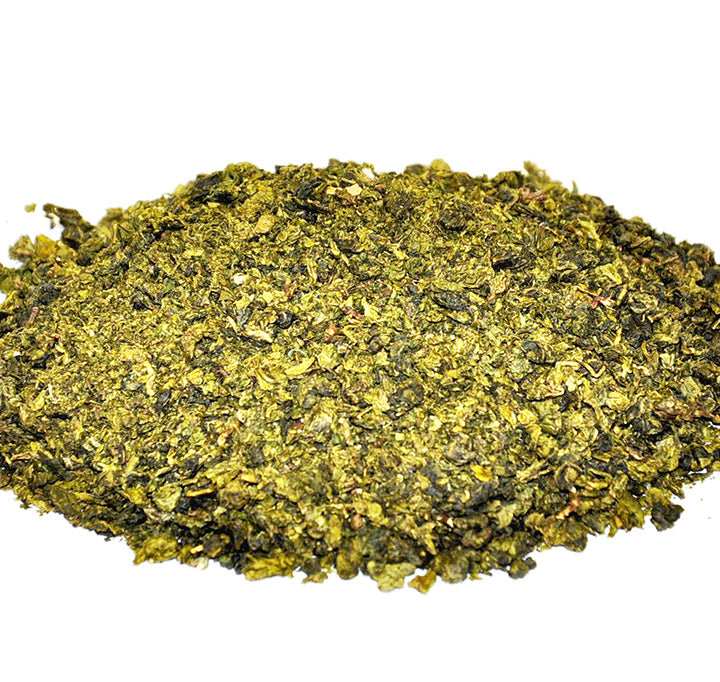Yellow Mountain Tea House
Milk Flavor Oolong Tea (Jin Xuan Oolong Tea)
Milk Flavor Oolong Tea (Jin Xuan Oolong Tea)
Couldn't load pickup availability
Milk Flavor oolong Tea (Jin Xuan Oolong Tea)
Jin Xuan (金萱; pinyin: jīn xuān; literally "Golden Daylily") is a 1980 developed variety of Oolong tea. The tea is also known as #12 or as "Milk Oolong" (Nai Xiang). It originates from Taiwan. The taste is light and flowery and sometimes compared to milk. This tea variety can be grown at higher altitudes, and the yield is about 20% higher compared to traditional tea varieties. These circumstances made it become one of the most popular varieties among tea farmers in Taiwan and Thailand.[1] The widely advertised milky flavor of Jin Xuan is not always natural but is added by aromatization[citation needed]. The common method of flavoring the leaves further to accentuate their characteristic buttery taste is to steep or steam them in milk before roasting. However, this quality is varietally endemic to the tea, and similar taste enhancement can be produced by extra oxidization. Reputable dealers usually declare whether it is a natural or flavored oolong. A flavored Jin Xuan can be recognized before the tea is steeped. The added flavors mask the natural tea flavor significantly. The Milk Oolong we have are nature, especially after you tasting it , you able to tell the difference between the nature one and the added flavor ones
Brewing Instruction:
Brewing tool: cups, bottles, tea wears, tea bags
Water temperature: 207° F
Amount of tea: 1 - 1.5 teaspoon
Amount of water: 6-10 oz.
Steeping Time:
Put the hot water into the cup with the tea, stirring the tea will make the tea flavor come out faster, stir about 20 - 30 seconds for the first cup, strain it out. Later if you want more tea, put more water back in the cup, steep for another 30 - 50 seconds, then strain it. This amount of tea leaves will make 3 - 4 cups of tea.
Try to keep infusion time to 10 - 20 seconds. Don’t worry if the tea isn’t very stronger – it’s not supposed to be, at least not in the beginning. After 2 - 3 brews, the leaves will wake up and start yielding a darker, stronger brown beverage. That’s when you should keep steeping time just under 20 seconds, or the tea might develop bitter notes. After another 3 - 4 brews, as the potency of the tea decreases, feel free to gradually increase the length of infusion to maintain the desired level of strength
Drinking tips:
- Do not steep oolong tea too long. Oolong tea is half-fermented and still have a lot of tea polyphenols, alkaloids and other nutrients like green tea, if you drink it too strong the nutrients have a too strong reaction it will irritate the stomach or dilute the stomach acid causing digestion problems or stomach aches. For more experienced green tea drinkers a strong brew will be fine.
- If brew oolong tea with hot water, drink the tea while still hot. We suggest drinking all the oolong tea you brewed within 60 - 90minutes. If the oolong tea sits too long like green tea it will oxidize lose the nutrients. If you want drink cold tea, use cold water to brew. It will take about 20 - 90 minutes to steep. Once the tea turns green and brown color, it is ready to drink.
- We suggest drinking the oolong tea 30minutes-60minutes after meal. Drinking too soon after the meal, the tea will reactor with the nutrients of the food, especially the iron and protein. So if you have anemia, do not drink green tea, black tea, oolong tea, and pu-erh tea.
Health benefits of oolong tea include the reduction of chronic health conditions such as heart disease, inflammatory disorders, and high cholesterol levels,high blood pressure,high blood sugar, while providing vital antioxidants, promoting superior bone structure, robust skin and good dental health. Oolong tea is fragrant with a fruity flavor and a pleasant aroma. Despite its caffeine content, it can still be extremely relaxing to drink.It is very good for detoxing, get rid of the toxins and fat out of the body.
The health benefits of oolong tea are basically doubled because of the combined qualities of black tea andgreen tea. According to the Tea Association of the United States, oolong tea falls somewhere between green and black teas, as its leaves are only partially oxidized. There are numerous kinds of tea in this world; but oolong tea might be one of the most beneficial.
The origins of oolong tea date back almost 400 years, when it found wide usage in China. It is a semi-green fermented tea, but the fermentation process is halted as soon as the tea leaves start to change their color.
Nutritional Value of Oolong Tea
Tea is a natural gift that is rich in antioxidants. It also contains vital vitamins and minerals such as calcium,manganese, copper, carotin, selenium, and potassium, as well as Vitamin A, B, C, E and K. Additionally, it contains folic acid, niacin amide and other detoxifying alkaloids. It is developed in semi-fermented processing, providing the oolong tea with numerous polyphenolic compounds, adding even more valuable health benefits to oolong tea. Oolong tea also contains caffeine and theophylline and theobromine which are similar to caffeine which on consumption may stimulate nervous system.
Share


